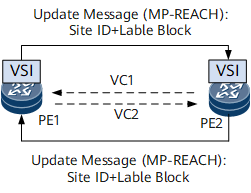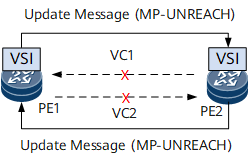BGP VPLS
Background
BGP VPLS uses a dynamic discovery mechanism to discover VPLS members using BGP signaling. BGP VPLS uses MP-BGP Update packets to transmit VPLS member information. In an MP-BGP Update packet, the MP-REACH and MP-UNREACH attributes carry VPLS label information, and the extended community attributes carry interface parameters, RDs, and VPN targets. The RDs and VPN targets are used to identify VPN member relationships.
Related Concepts
BGP VPLS involves the following concepts:
- MP-BGP: A multi-protocol extension of BGP-4. MP-BGP supports multiple network-layer protocols and identifies protocols based on address families. MP-BGP transmits VPN member information and VPN-IPv4 routes between PEs. Compared with conventional BGP, MP-BGP introduces the following path attributes:
- MP_REACH: advertises reachable routes and their next hops.
- MP_UNREACH: instructs a peer to delete unreachable routes.
Implementation
Figure 1 shows the process of establishing a PW using BGP signaling.
- PE1 is configured with a local label block. If a BGP session has been established between PE1 and PE2, PE1 sends an MP-BGP Update packet carrying the MP-REACH attribute, site ID, and label block information to PE2.
- Upon receipt of the MP-BGP Update packet, PE2 calculates a unique label as its local VC label based on its own site ID and the label block carried in the packet. Then PE2 establishes a unidirectional VC named VC1. PE2 also calculates the local VC label of PE1 based on the site ID carried in the packet and its local label block and sends an MP-BGP Update packet to PE1. Upon receipt of the MP-BGP Update packet, PE1 takes similar actions as PE2 does and establishes a unidirectional VC named VC2.
Figure 2 shows the process of tearing down a PW using BGP signaling.
- After the local label block is deleted from PE1, PE1 withdraws its local VC label and tears down VC2. Additionally, PE1 sends an MP-BGP Update packet carrying the MP-UNREACH attribute to PE2.
- Upon receipt of the MP-BGP Update packet, PE2 withdraws its local VC label and tears down VC1.
Derivative Functions
Ignoring MTU Match Check Results
By default, a VSI MTU check is performed on both ends of a VC in a VSI. If VSI MTUs on the two ends do not match, the VC cannot go Up.
When Huawei devices interwork with non-Huawei devices that do not support the VSI MTU check, configure the Huawei devices to ignore VSI MTU check results and encapsulate VPLS packets in the standard type 19 format.
RRs Not Filtering Received VPN Routes or Label Blocks Based on VPN Targets
Full-mesh connections need to be established between IBGP peers to ensure interconnectivity between them. If there are n BGP speakers in an AS, n(n-1)/2 IBGP connections need to be established. Establishing full-mesh connections for a large number of IBGP peers consumes lots of network resources.
In an AS, one router serves as the RR, although; whereas the other routers serve as clients. The clients establish IBGP connections with the RR. The RR and its clients form a cluster. The RR reflects routes among the clients, eliminating the need for the clients to establish BGP connections with each other. In an AS with n routers, if one router serves as the RR and others serve as clients, only (n-1) IBGP connections need to be established. This implementation greatly reduces the consumption of network and CPU resources.
After an RR is configured, VPNs or VPN targets no longer need to be configured on RR, eliminating the need for the RR to save VPN routes or label blocks. In this situation, VPN-target-based filtering must be disabled for received VPN routes or label blocks.
Support for Intercommunication Between the L2VPN-AD Address Family and the BGP VPLS Address Family on the Peer Device
Both the BGP VPLS address family and L2VPN-AD address family use the standard 25/65 address family. When the L2VPN-AD address family receives the encapsulation type of 4 or 5 from the peer end, it determines the BGP VLL if the TLV sent by the peer end carries the CSV flag (identifying the PW status) and BGP VPLS if the TLV does not carry the CSV flag.
Usage Scenario
BGP VPLS applies to the core layers of large-scale networks with BGP-running PEs.
Benefits
BGP VPLS offers the following benefits:
- Provides a dynamic discovery mechanism to discover VPN members, thereby simplifying user operations
- Improves network expansibility by using RRs to reduce the number of BGP connections

